Ghana. ‘Hogbetsotso’, a Festival of the Exodus.
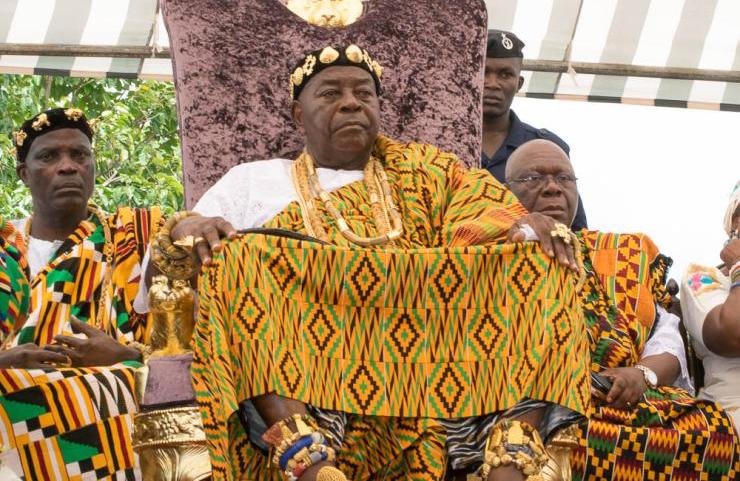
It is one of the indigenous festivals in Ghana celebrated by the Anlo people of Southern Ghana to commemorate the escape from the region of Notsie in Togo to their present abode in the Volta Region of Ghana between the 14th and the 15th centuries.
Hogbetsotso is a festival that reminds the Anlo people of their ancestry. It rekindles the bond of relationship that existed between them and other Ewe-speaking people and also affords the citizens the opportunity to appraise their development programmes in the past year. The festival is an occasion when the whole of Anlo is open to visitors and where the full cultural value of the people is put on display.
The term Hogbetsotso, according to history, was derived from three words from Ewe language spoken by the people of Volta Region- ‘Ho’, meaning to uproot or move, ‘Gbe’ meaning day and ‘Tsotso’, meaning crossing over. So literally, Hogbetsotso means the day the people rose up and moved out of Notsie. The Hogbetsotso Festival is also known as the Festival of Exodus. It stems from the Ewe word ‘Hogbe’ or ‘Hohogbe’, meaning the day of the Exodus.
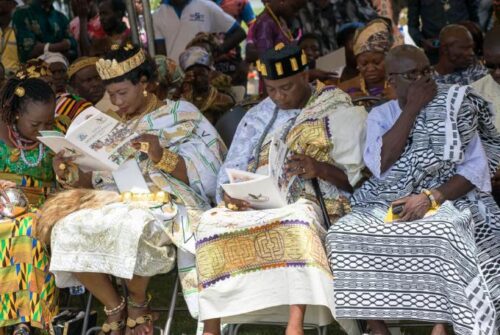
Chiefs dress in very colourful regalia and sit in state to receive homage from their subjects. (Photo Anlo State).
This historic festival is a day that unfolds Ewe history and brings to play the memories of legendary exodus and heroic acts of men of boldness and their mystical powers that liberated the Ewe-Dogbo people from the rule of ‘tyrant’ King of Kings Torgbui Agorkorli of Notsie in Togo
by walking backward.
Notsie is seen as the place of a major exodus of the Anlo ancestry. In order to commemorate the exodus and the bravery of their traditional rulers who led them on the journey, the people created this annual ‘Festival of the Exodus’. The Anlos are believed to have migrated from Southern Sudan to Notsie, their ancestral federated region (now within the territory of the modern State of Togo), and then to their current home on the eastern coast of Ghana in the late 15th century (1474). The Anlos initially resided in Yorubaland, close to the Benin-Nigeria border, before relocating to Notsie in central Togo, according to history.
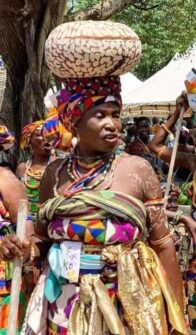
Woman in traditional dress on her way to the festival. (Photo Anlo State)
The Hogbetsotso is celebrated in the month of November at Anloga, a town in the Southern Volta of Ghana which is the traditional and ritual capital of the Anlo State. Anloga, also a town marked by a meandering lagoon and golden sand beaches overhanging the Atlantic Ocean, is where the grand durbar is held on every first Saturday in November. The celebration is divided into three activities: Peacemaking ceremony, Purification or ‘dodede’, and a Durbar. The festival is celebrated at Anloga by the Anlo people from Anloga, Keta, Abor, Vodza, Whuti, Dzita, Kedzi, Afiadenyegba, Srogbe, Alakpe, Konu, Atito, Atiavi, Tsiame, and Devegodo, among other villages.
The Anlo-Ewes begin the observance of Hogbetsotso with a period of peacemaking, during which any outstanding problems are resolved. On the last Thursday before the day of the durbar, the ritual performed is aimed at social reconciliation. This activity is aimed at reconciling individuals and groups within the 36 Anlo states. Known as ‘Nugbidodo’ meaning reconciliation, the residents of Anlo strive for peace among themselves at all times.
The belief is that the ancestors dislike unresolved disagreements and misunderstandings because they bring illness and impede development. To resolve any small squabbles, ‘nugbidodo’ is conducted among family members, lineages, clans, and traditional rulers. Moreover, it is widely believed that the Hogbetsotso festival will not be successful until this rite is properly executed.
‘Hanududu’ is one of the events that should not be missed by visitors. It is time when all married landlords give supplies for their wives to prepare meals, and an open house is hosted to that effect. The idea is that people who fight don’t eat together. As a result, this is organised to compel people to feast together, resulting in reconciliation amongst all parties involved and an expression of harmony among family members, clans, and the general public.
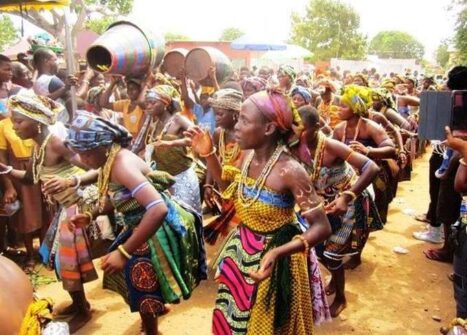
Hogbetsotso is a festival that reminds the Anlo people of their ancestry. (Photo Anlo State)
Another important ritual is the state cleansing and sanitation programme known as ‘Dodede’ and ‘Apekplorkplor’ which is also performed by recognised seers. These are events aimed at cleaning up the nearby area. This cleaning ceremony begins at the Volta Estuary and goes on for days until it finally reaches the Mono River in the Republic of Benin. An essential aspect of the festival is a durbar of chiefs and the people. Chiefs dress in very colourful regalia and sit in state to receive homage from their subjects.
The ‘dodede’ rite, which literally means ‘disease removal’, entails the eradication of ailments , as well as the expulsion of bad spirits, believed to be the source of these maladies.
‘Dodede’ is seen to be a good way for individuals to connect with the Supreme God (Mawu), the lower gods (trowo), and their ancestors (togbinoliawo), and it is a completely private rite. There are many other ceremonies associated with the festival, including a purification ceremony of the traditional stool and a period of general cleaning when the villages are swept and rubbish burnt, and dancing, singing, and general merry-making going on throughout the festival.
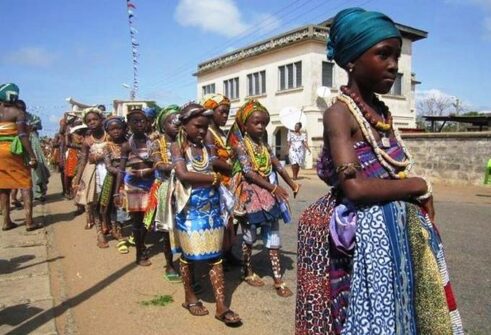
Children are on their way to the festival. (Photo Anlo State)
During the celebration of this festival, many art forms which contribute to the success and pageantry of the festival are exhibited. One of the most significant rituals that precedes the Hogbetsotso festival is a state divination which is performed by distinguished seers selected from major towns throughout the 36 Anlo States. Once the seers have announced the rituals that need to be carried out, the traditional priests perform the appropriate ceremony invoking the gods of the land. After that, all the seers gather at ‘Atiteti’, one of the Anlo towns on the estuary of the Volta Lake to perform additional sacrifices.
A day is set aside to illustrate how the hostages’ departure or escape was orchestrated. To deceive the king and his elders, the departing party marched backward, giving the impression that they were approaching rather than fleeing Notsie. The ‘Misego’ or ‘Husago’ dance, which is thought to be the vehicle for the exodus, is used to reenact this occurrence today during the Hogbetsotso.
The chiefs and the people of Anlo climax their month-long Hogbetsotso Festival with a grand durbar which attracts traditional authorities from other kingdoms, who are accompanied by large retinues of sub-chiefs and courtiers, amidst beautiful displays of art and culture. The durbar forms a significant part of the week-long Hogbetsotso festival which brings together all the chiefs and elders of Anlo-land at a colourful durbar to mark the annual event in the Volta Region. Due to the rich culture of the Hogbetsotso festival and its historical background, various Ewe cultural troupes from Benin, Nigeria, and the Diaspora have opportunities to put up performances to illustrate the migration of the Anlos from Notsie in Togo to their present location.
Drumming and dancing are essential components of any festival, and the Hogbetsotso is no different.
During the durbar, people from all around Ghana, the Diaspora, and foreigners gather in large numbers to express respect for the paramount chief, who had hitherto avoided public visibility.
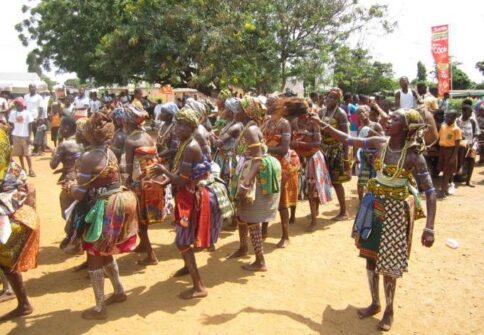
The entire festival period is marked by singing, dancing and merry-making. (Photo: Ministry Of Tourism, Arts & Culture)
As it’s a cultural event, the chiefs of the Anlo people led by the ‘Awoemefia’ (Paramount Chief of the Anlo State), currently Torgbui Sri III dress up in colorful traditional clothing known as the regalia. They sit on a raised platform, addressing the Anlo community while locals watch over. The entire festival period is marked by singing, dancing and merry-making. Born of age-old oral legend, the Hogbetsotso festival has been celebrated for generations.
The ‘Agbadza’, the traditional dance of the people of Anlo which is performed vigorously during the grand durbar of the Hogbetsotso festival. It is a way of expressing joy to their ancestors and gods. The ‘Agbadza’ is a staple during the Hogbetsotso providing a glimpse of the Anlo community’s culture and history. Agbadza was formerly known as ‘Atrikpui’, which imitates the flying birds. Sometimes the people, especially the women, dance backwards while carrying their baggage with a stick in their hands and as they move, they watch from left to right to illustrate their departure from Notsie.
The women dress in a manner that reveals their backsides known as ‘Atufu’. Historically, it is said that that is where the women kept their most valuable possessions while embarking on their journey from Notsie. (Open Photo: The Awoamefia of the Anlo State, Torgbui Sri III. Anlo State)
Damian Dieu Donne Avevor



